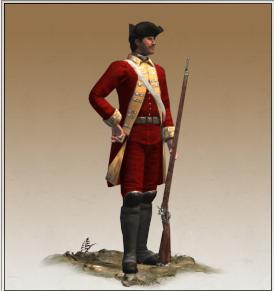Line Infantry (ETW Unit)
Line Infantry
Unit Description
These musket-armed troops use massed volleys to break an enemy, relying on discipline to withstand any counter fire.
"Marching regiments" and "line battalions" make up the majority of units in European-style armies. They are so called because they form the lines of battle, not because they always deploy in lines. Indeed, over time the capabilities of line infantry should improve as new tactics, drills and weaponry are developed.
These soldiers carry muzzle-loading, smoothbore muskets firing lead balls as wide as a man's thumb. These inaccurate weapons, effective only over 200 yards or so and when fired in massed volleys. The ability to fire and reload with machine-like regularity with shot and bullets flying and comrades falling all around is what wins battles.
Historically, in many armies colonels received a fee to raise regiments, which remained their personal property and commands. They jealously guarded thier right to appoint friends, relatives and hangers-on as regimental officers. This contractor system, however, allowed unscrupulous officers to make handsome profits by pocketing the pay of non-existent soldiers. The better colonels did take a pride in their regiments, spending their fortunes on good uniforms and weapons. The capabilities of a "standard" line infantry unit therfore varied between nations and over time. It wasn't until the 1760's that anything approaching uniformity of drill, equipment and regulations became the norm.
Line infantry regiments remained unchanged throughout the period, and their organisational patterns still form the basis of modern military units.
Statistics
See below!
Factional Differences
See table below. IR=Irish Line Infantry ETR=Etrangere Line Infantry
| Faction Name | Men | Range | Accuracy | Reload Skill | Ammo | Melee | Charge | Defense | Morale | Upkeep |
|---|---|---|---|---|---|---|---|---|---|---|
| Austria | 150 | 70 | 40 | 20 | 10 | 7 | 4 | 11 | 8 | 310 |
| Great Britain | 120 | 70 | 45 | 30 | 10 | 8 | 5 | 15 | 10 | 300 |
| France | 120 | 70 | 45 | 25 | 10 | 10 (ETR=8) | 6(ETR=5) | 9(ETR=11) | 8 | 290 |
| The Maratha Confederacy | 120 | 70 | 40 | 25 | 10 | 4 | 4 | 9 | 9 | 290 |
| Ottoman Empire | 120 | 70 | 35 | 25 | 10 | 6 | 4 | 11 | 7 | 260 |
| Poland-Lithuania | 120 | 70 | 45 | 25 | 10 | 8 | 5 | 13 | 9 | 280 |
| Prussia | 120 | 70 | 45 | 35 | 10 | 8 | 7 | 14 | 10 | 300 |
| Russia | 120 | 70 | 35 | 25 | 10 | 8 | 8 | 12 | 9 | 280 |
| Spain | 120 | 70 | 45 | 25 (IR=20) | 10 | 8 (IR=10) | 5 | 13 | 9 | 280 |
| United Provinces | 120 | 70 | 45 | 25 | 10 | 8 | 5 | 13 | 9 | 280 |
| Sweden | 120 | 70 | 45 | 25 | 10 | 8 | 5 | 13 | 9 | 280 |
Tactics
Enter your tactics and strategies here!
The standard Line Infantry tactic is to line your men up facing the enemy. However, during the Early Era only your front rank can fire so an incredibly thin line is useful here as you can bare more muskets down on the enemy.
During the Mid Era after unlocking 'Platoon Fire' your men can fire now no matter what rank they are in. So a 2/3 rank line is useful here.
During the Late Era after unlocking 'Rank Fire' your front row will fire, kneel then the second row will fire then kneel and so on. This is the best type of firing for your Line Infantry as you can keep an almost continual stream of musket balls against your opponent. Here 3 ranks is just right as there is only a short delay between the 3rd rank firing and the 1st rank standing and firing.
When being attacked by Calvary the best tactic is to form a square. This tactic is unlocked in the Early Era by a researched technology.
